人教版(2019) 必修第一册 Welcome unit 英语句子成分课件(22张PPT)
文档属性
| 名称 | 人教版(2019) 必修第一册 Welcome unit 英语句子成分课件(22张PPT) |  | |
| 格式 | pptx | ||
| 文件大小 | 827.2KB | ||
| 资源类型 | 教案 | ||
| 版本资源 | 人教版(2019) | ||
| 科目 | 英语 | ||
| 更新时间 | 2022-10-16 11:30:29 | ||
图片预览

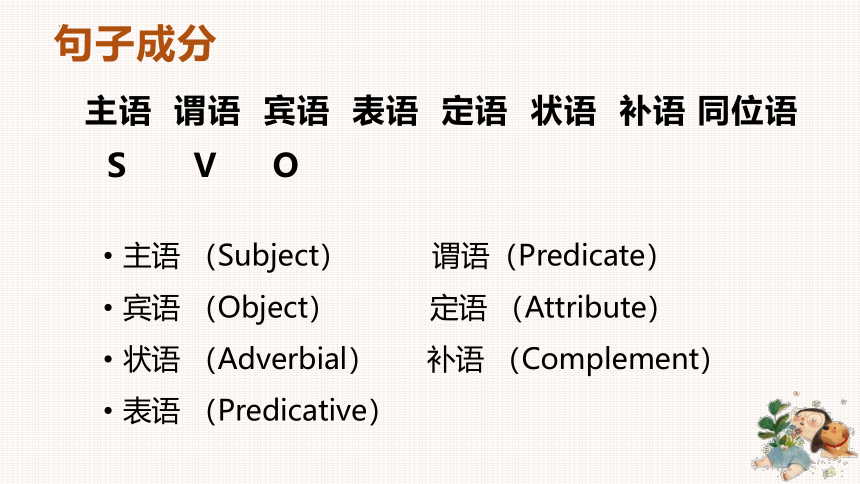
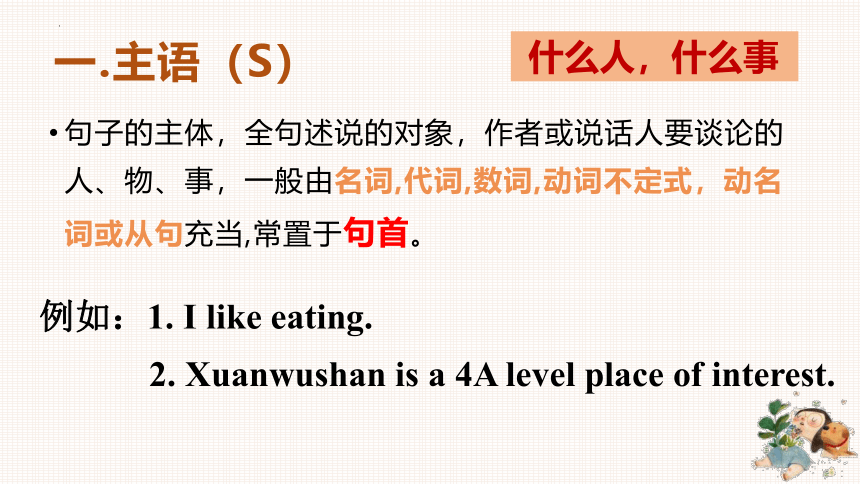

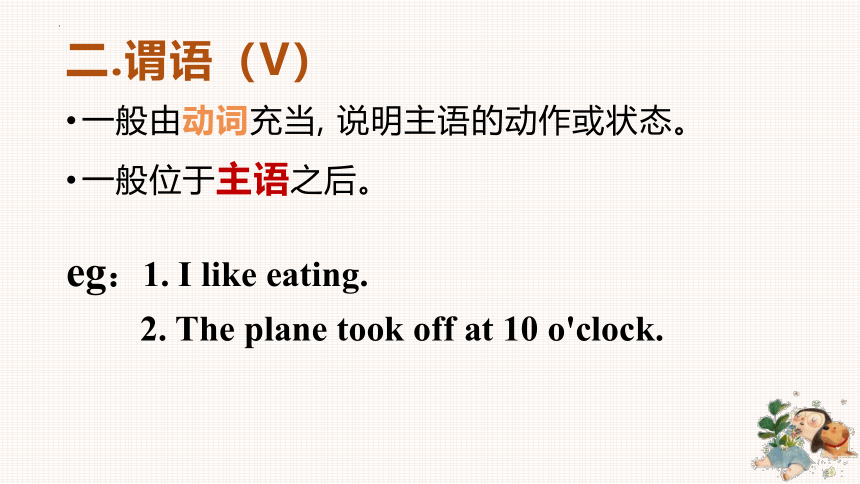
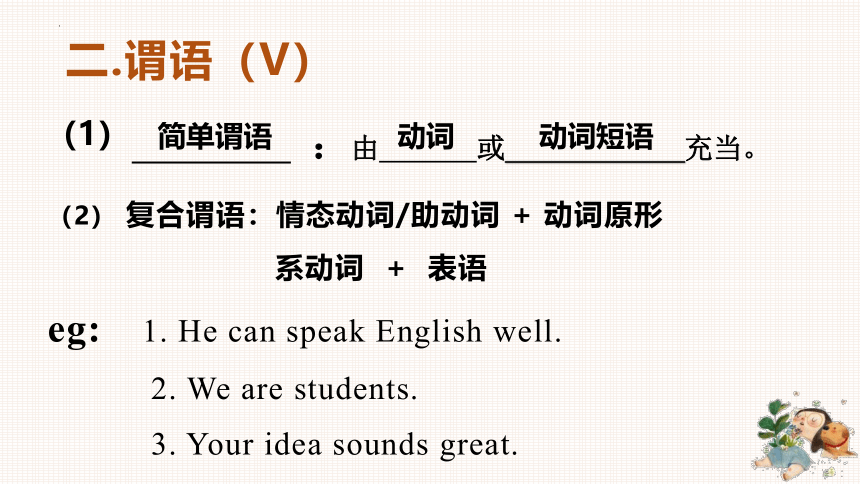
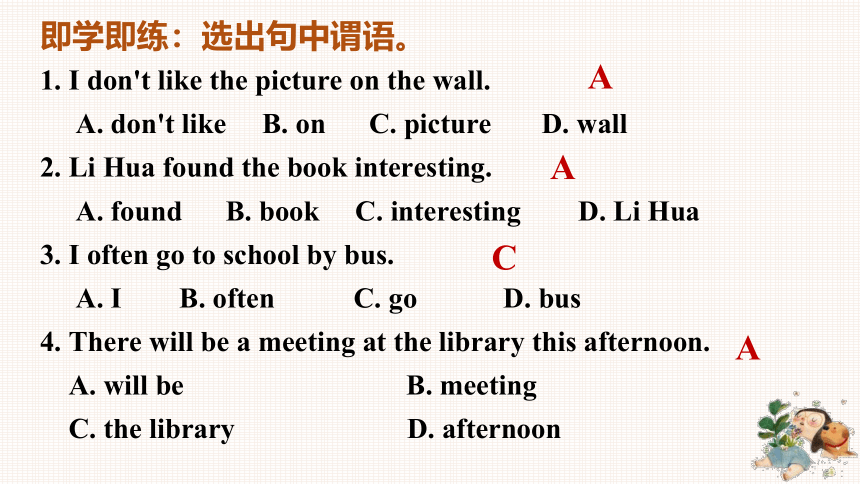
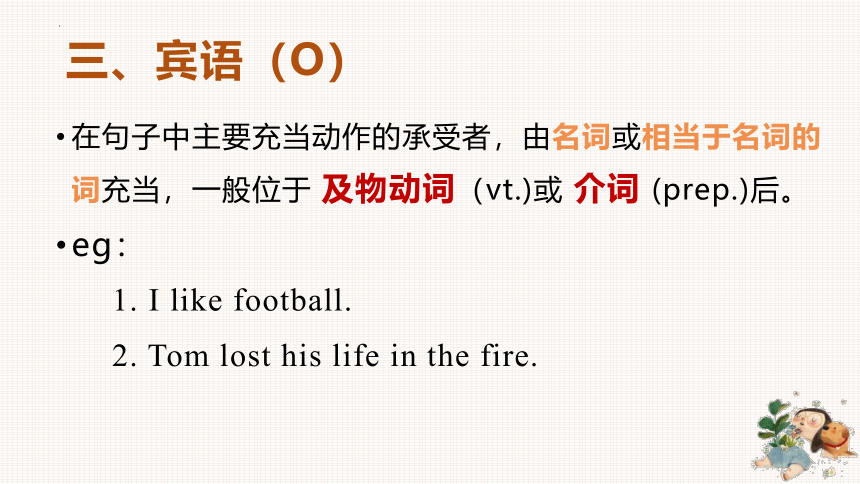
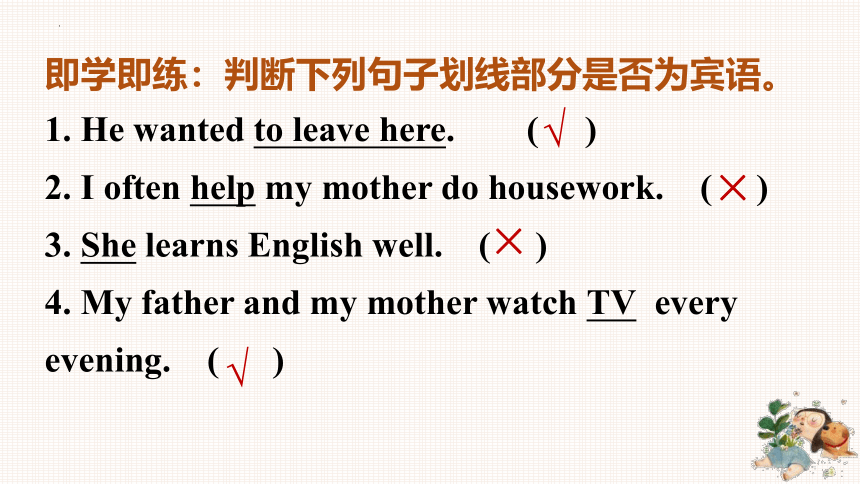
文档简介
(共22张PPT)
2022.9.6
句子成分与结构
句子成分
主语 谓语 宾语 表语 定语 状语 补语 同位语
S V O
主语 (Subject) 谓语(Predicate)
宾语 (Object) 定语 (Attribute)
状语 (Adverbial) 补语 (Complement)
表语 (Predicative)
一.主语(S)
句子的主体,全句述说的对象,作者或说话人要谈论的人、物、事,一般由名词,代词,数词,动词不定式,动名词或从句充当,常置于句首。
例如:1. I like eating.
2. Xuanwushan is a 4A level place of interest.
什么人,什么事
1. We speak English in class.
2. To see is to believe.
3. Smoking is bad for our health.
4. China is a big country.
即学即练:划出句子的主语。
(代词)
(动词不定式)
(动名词)
(名词)
二.谓语(V)
一般由动词充当, 说明主语的动作或状态。
一般位于主语之后。
eg:1. I like eating.
2. The plane took off at 10 o'clock.
二.谓语(V)
(2) 复合谓语:情态动词/助动词 + 动词原形
系动词 + 表语
eg: 1. He can speak English well.
2. We are students.
3. Your idea sounds great.
:由 或 充当。
动词
动词短语
简单谓语
(1)
即学即练:选出句中谓语。
1. I don't like the picture on the wall.
A. don't like B. on C. picture D. wall
2. Li Hua found the book interesting.
A. found B. book C. interesting D. Li Hua
3. I often go to school by bus.
A. I B. often C. go D. bus
4. There will be a meeting at the library this afternoon.
A. will be B. meeting
C. the library D. afternoon
A
A
A
C
三、宾语(O)
在句子中主要充当动作的承受者,由名词或相当于名词的词充当,一般位于 及物动词(vt.)或 介词 (prep.)后。
eg:
1. I like football.
2. Tom lost his life in the fire.
即学即练:判断下列句子划线部分是否为宾语。
1. He wanted to leave here. ( )
2. I often help my mother do housework. ( )
3. She learns English well. ( )
4. My father and my mother watch TV every evening. ( )
√
×
×
√
记忆口诀:
主语放句首;
谓语放主语后,快把动词找;
宾语 放于动词、介词后。
标出下列句子中划线部分的成分。
①宾语 ②主语 ③谓语
1. You must pay her immediately.
2. He gave me a book yesterday.
3. They respect teachers.
4. Some of the students want to go swimming.
四、表语(P)
用以表述主语的特征、状态、身份等。由名词 、 代词、数词、分词、不定式、动名词、副词、形容词、介词短语等充当。常位于系动词之后,构成所谓的系表结构。
eg:
1. I am a student.
2. She is beautiful.
常见的系动词有:
① be动词: 。
②感官系动词 ,
③变化系动词表示主语变成什么样,主要有 become、get、go、grow、turn、fall、come,
④结果类系动词有 prove、turn out
⑤持续系动词有 keep、stay、remain
⑥表像系动词用来表示“看起来像”,主要有seem、
appear、look。
am、is、are、was、were 等
feel、smell、sound、taste、look
即学即练:划出下列句中的表语。
① The old man was feeling tired.
② The leaves have turned yellow.
③ Soon they all became interested in the subject.
④ She was the first to learn about it.
五、补语(C)
补语主要分为主补和宾补。
宾补:英语中有些及物动词后接宾语,意义仍不完整,还需要一个补足语,才能使整个句子的意义完整。由名词 、副词、形容词 、分词、不定式、介词短语和从句等充当。
eg:
1. We saw her entering the house.
2. I want your homework finished on time.
五、补语(C)
补语主要分为主补和宾补。
主补:对主语的补充,含有宾语补足语的句子在变成被动语态后,即宾语变为主语,原来的宾补就变为主补。
eg:
1. She was found singing in the next room.
2. He was elected monitor.
六、状语
状语:修饰动词、形容词、副词或者整个句子。当一个句子中有几个并列状语时,顺序一般是:方式--地点--时间
频度副词(often,always,usually,sometimes,never),位于实义动词之前,情态动词、助动词、系动词之后。
七、定语
定语:是对名词或代词起修饰、限定作用的词,短语,句子。常表示“...的”。由名词、代词、数词、分词、不定式、动名词、副词、形容词、介词短语从句等充当。
P7
八、同位语
同位语:是对名词或代词之后,并对前者做进一步解释、补充说明的成分。
eg:
1. We students should study hard.
2. They, some railway workers, are busy repairing the train.
3. The young man, my brother, works in the office.
同位语
对名词或代词做进一步解释补充说明的成分,指的是同一个事物,可以去掉但不影响句子的理解。
·定语
对名词或代词起修饰限定作用的成分,去掉之后可能会使句子意思不明确。
VS
同位语? or 定语?
1. You two come and sit here.
2. People there are very friendly.
3. All chinese people, old and young, are expecting the happy news.
4. A boy in the class is talking with another boy.
5. There is something interesting.
同位语
定语
同位语
定语
定语
Thank you
2022.9.6
句子成分与结构
句子成分
主语 谓语 宾语 表语 定语 状语 补语 同位语
S V O
主语 (Subject) 谓语(Predicate)
宾语 (Object) 定语 (Attribute)
状语 (Adverbial) 补语 (Complement)
表语 (Predicative)
一.主语(S)
句子的主体,全句述说的对象,作者或说话人要谈论的人、物、事,一般由名词,代词,数词,动词不定式,动名词或从句充当,常置于句首。
例如:1. I like eating.
2. Xuanwushan is a 4A level place of interest.
什么人,什么事
1. We speak English in class.
2. To see is to believe.
3. Smoking is bad for our health.
4. China is a big country.
即学即练:划出句子的主语。
(代词)
(动词不定式)
(动名词)
(名词)
二.谓语(V)
一般由动词充当, 说明主语的动作或状态。
一般位于主语之后。
eg:1. I like eating.
2. The plane took off at 10 o'clock.
二.谓语(V)
(2) 复合谓语:情态动词/助动词 + 动词原形
系动词 + 表语
eg: 1. He can speak English well.
2. We are students.
3. Your idea sounds great.
:由 或 充当。
动词
动词短语
简单谓语
(1)
即学即练:选出句中谓语。
1. I don't like the picture on the wall.
A. don't like B. on C. picture D. wall
2. Li Hua found the book interesting.
A. found B. book C. interesting D. Li Hua
3. I often go to school by bus.
A. I B. often C. go D. bus
4. There will be a meeting at the library this afternoon.
A. will be B. meeting
C. the library D. afternoon
A
A
A
C
三、宾语(O)
在句子中主要充当动作的承受者,由名词或相当于名词的词充当,一般位于 及物动词(vt.)或 介词 (prep.)后。
eg:
1. I like football.
2. Tom lost his life in the fire.
即学即练:判断下列句子划线部分是否为宾语。
1. He wanted to leave here. ( )
2. I often help my mother do housework. ( )
3. She learns English well. ( )
4. My father and my mother watch TV every evening. ( )
√
×
×
√
记忆口诀:
主语放句首;
谓语放主语后,快把动词找;
宾语 放于动词、介词后。
标出下列句子中划线部分的成分。
①宾语 ②主语 ③谓语
1. You must pay her immediately.
2. He gave me a book yesterday.
3. They respect teachers.
4. Some of the students want to go swimming.
四、表语(P)
用以表述主语的特征、状态、身份等。由名词 、 代词、数词、分词、不定式、动名词、副词、形容词、介词短语等充当。常位于系动词之后,构成所谓的系表结构。
eg:
1. I am a student.
2. She is beautiful.
常见的系动词有:
① be动词: 。
②感官系动词 ,
③变化系动词表示主语变成什么样,主要有 become、get、go、grow、turn、fall、come,
④结果类系动词有 prove、turn out
⑤持续系动词有 keep、stay、remain
⑥表像系动词用来表示“看起来像”,主要有seem、
appear、look。
am、is、are、was、were 等
feel、smell、sound、taste、look
即学即练:划出下列句中的表语。
① The old man was feeling tired.
② The leaves have turned yellow.
③ Soon they all became interested in the subject.
④ She was the first to learn about it.
五、补语(C)
补语主要分为主补和宾补。
宾补:英语中有些及物动词后接宾语,意义仍不完整,还需要一个补足语,才能使整个句子的意义完整。由名词 、副词、形容词 、分词、不定式、介词短语和从句等充当。
eg:
1. We saw her entering the house.
2. I want your homework finished on time.
五、补语(C)
补语主要分为主补和宾补。
主补:对主语的补充,含有宾语补足语的句子在变成被动语态后,即宾语变为主语,原来的宾补就变为主补。
eg:
1. She was found singing in the next room.
2. He was elected monitor.
六、状语
状语:修饰动词、形容词、副词或者整个句子。当一个句子中有几个并列状语时,顺序一般是:方式--地点--时间
频度副词(often,always,usually,sometimes,never),位于实义动词之前,情态动词、助动词、系动词之后。
七、定语
定语:是对名词或代词起修饰、限定作用的词,短语,句子。常表示“...的”。由名词、代词、数词、分词、不定式、动名词、副词、形容词、介词短语从句等充当。
P7
八、同位语
同位语:是对名词或代词之后,并对前者做进一步解释、补充说明的成分。
eg:
1. We students should study hard.
2. They, some railway workers, are busy repairing the train.
3. The young man, my brother, works in the office.
同位语
对名词或代词做进一步解释补充说明的成分,指的是同一个事物,可以去掉但不影响句子的理解。
·定语
对名词或代词起修饰限定作用的成分,去掉之后可能会使句子意思不明确。
VS
同位语? or 定语?
1. You two come and sit here.
2. People there are very friendly.
3. All chinese people, old and young, are expecting the happy news.
4. A boy in the class is talking with another boy.
5. There is something interesting.
同位语
定语
同位语
定语
定语
Thank you
